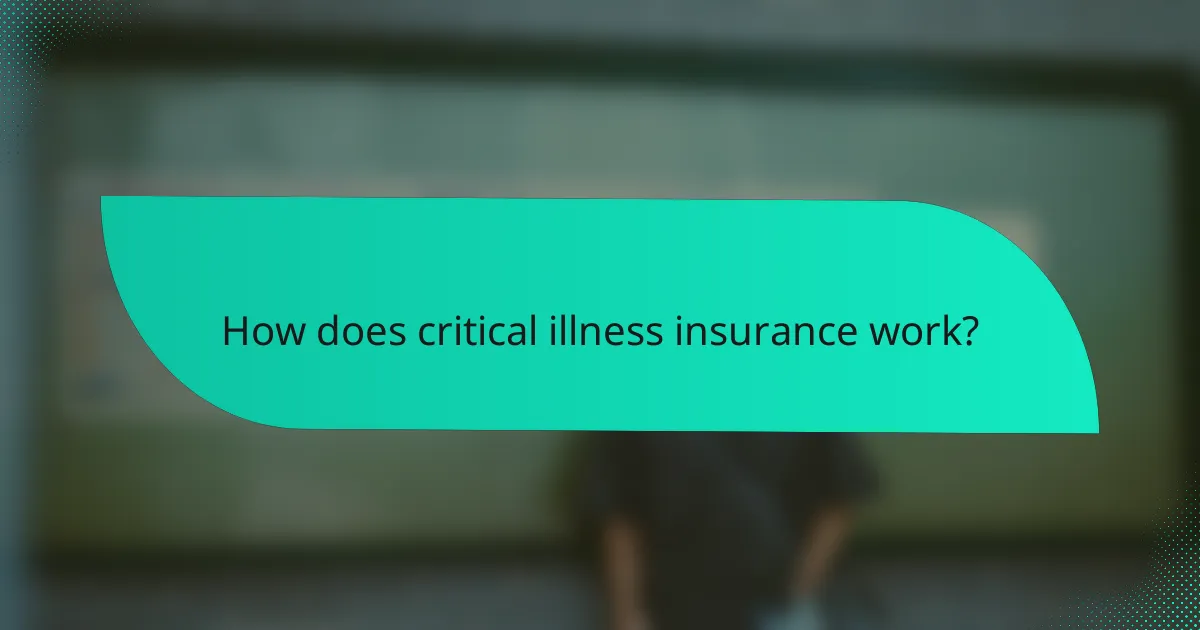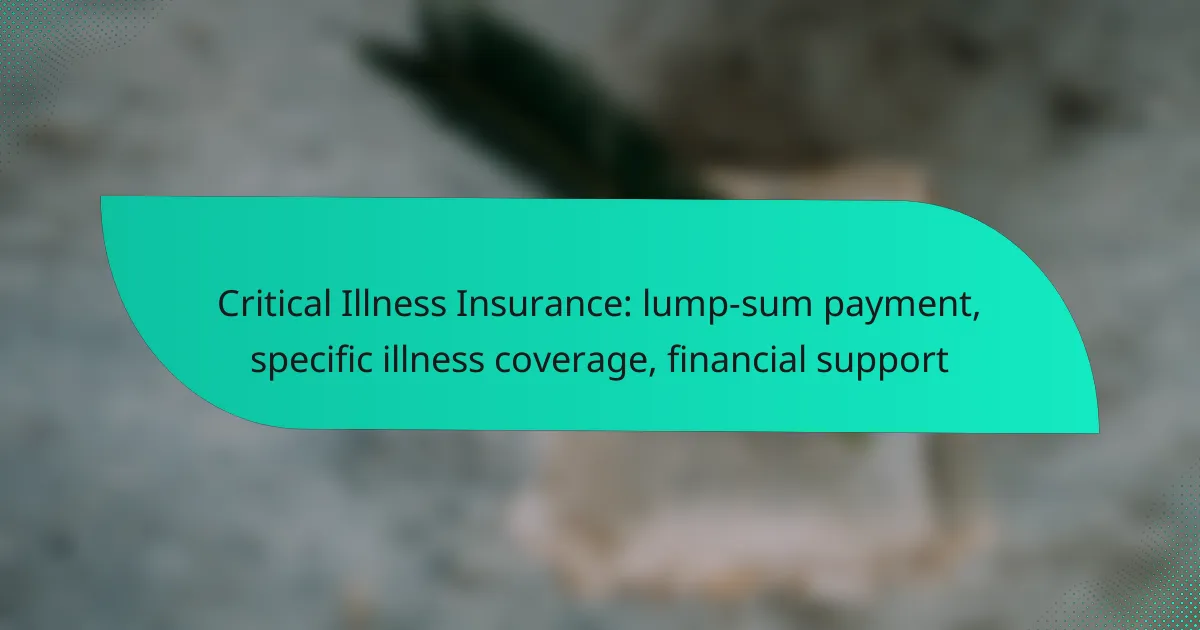Critical illness insurance offers a lump-sum payment upon diagnosis of specified serious illnesses, providing essential financial support during difficult times. This coverage helps policyholders manage medical expenses and lost income, ensuring they can maintain their quality of life while facing significant health challenges.

What is critical illness insurance?
Critical illness insurance provides a lump-sum payment if you are diagnosed with a specified serious illness. This financial support can help cover medical expenses, lost income, or other costs associated with your condition.
Definition of critical illness insurance
Critical illness insurance is a type of policy that pays out a predetermined amount when the insured is diagnosed with a serious illness, such as cancer, heart attack, or stroke. The specific illnesses covered vary by policy, so it’s essential to review the terms carefully.
Typically, these policies do not require you to use the funds for medical expenses; instead, you can allocate the money as needed, whether for treatment, rehabilitation, or everyday living costs.
Importance of critical illness insurance
Having critical illness insurance can provide significant peace of mind, as it helps mitigate the financial burden that serious health issues can impose. This coverage can be particularly crucial in countries where healthcare costs are high or where you may not have sufficient savings to cover unexpected medical expenses.
For example, in the United States, treatment for a critical illness can easily reach tens of thousands of dollars. A lump-sum payment from a critical illness policy can help ensure that you can focus on recovery rather than financial stress.

How does critical illness insurance work?
Critical illness insurance provides a lump-sum payment upon diagnosis of a covered serious illness, offering financial support during challenging times. This type of insurance helps policyholders manage medical expenses and maintain their quality of life while dealing with significant health issues.
Lump-sum payment structure
The lump-sum payment structure means that once you are diagnosed with a covered critical illness, you receive a predetermined amount of money. This payment can range from a few thousand to several hundred thousand dollars, depending on your policy and coverage level.
Receiving a lump sum allows you to use the funds as needed, whether for medical bills, living expenses, or alternative treatments. It’s essential to review your policy to understand the specific payout terms and conditions.
Specific illness coverage details
Critical illness insurance typically covers a range of serious conditions, such as heart attacks, strokes, and certain cancers. Each policy will specify which illnesses are included, so it’s crucial to read the fine print to know what is covered.
Some policies may also offer additional benefits for early diagnosis or specific treatments. Be aware that exclusions may apply, and understanding these details can help you choose the right coverage for your needs.

What illnesses are typically covered?
Critical illness insurance generally covers a range of serious health conditions that can significantly impact an individual’s life and finances. Policies often include major diseases such as cancer, heart attack, and stroke, providing a lump-sum payment upon diagnosis to help with medical expenses and other financial needs.
Common illnesses covered by policies
Most critical illness insurance policies cover a core set of illnesses, including cancer, heart attack, stroke, kidney failure, and major organ transplants. Some plans may also include conditions like multiple sclerosis, Parkinson’s disease, and Alzheimer’s disease. It’s essential to review the specific illnesses listed in your policy to understand what is covered.
For instance, a policy might provide coverage for 10 to 15 different illnesses, while others may offer broader or more specialized coverage. Always check the definitions and criteria for each illness, as they can vary by provider.
Variations in coverage by provider
Coverage for critical illnesses can vary significantly between insurance providers, affecting both the range of illnesses covered and the terms of the payout. Some insurers may offer additional riders or options to cover more conditions or provide higher payouts for specific illnesses.
When comparing policies, consider factors such as the number of covered illnesses, waiting periods, and any exclusions that may apply. It’s advisable to obtain quotes from multiple providers to find the best coverage that meets your needs and budget.

What are the benefits of critical illness insurance?
Critical illness insurance provides a lump-sum payment upon diagnosis of a covered illness, offering financial support during a challenging time. This type of insurance helps policyholders manage medical expenses and maintain their quality of life while focusing on recovery.
Financial support during illness
One of the primary benefits of critical illness insurance is the financial support it offers during a serious health crisis. The lump-sum payment can be used to cover medical bills, rehabilitation costs, or even everyday expenses like mortgage payments and groceries. This support can alleviate the financial burden, allowing individuals to concentrate on their health.
When considering critical illness insurance, it’s essential to review the specific illnesses covered by the policy. Commonly covered conditions include heart attacks, strokes, and certain cancers. Understanding the terms and conditions can help ensure that the policy meets your needs and provides adequate coverage.
Peace of mind for policyholders
Critical illness insurance provides peace of mind for policyholders, knowing they have financial protection in case of a severe health issue. This assurance can reduce stress and anxiety, allowing individuals to focus on their recovery without the added worry of financial instability.
Moreover, having this insurance can encourage proactive health management. Knowing that you are covered in case of critical illness may motivate you to maintain a healthier lifestyle, attend regular check-ups, and seek preventive care. This proactive approach can lead to better health outcomes and overall well-being.

How to choose the right critical illness insurance?
Choosing the right critical illness insurance involves evaluating your specific needs and understanding the coverage options available. Focus on the illnesses covered, the lump-sum payment structure, and how the policy aligns with your financial situation.
Factors to consider when selecting a policy
When selecting a critical illness insurance policy, consider the range of illnesses covered. Most policies typically cover major conditions like cancer, heart attack, and stroke, but some may include additional illnesses. Review the definitions and requirements for each condition to ensure they meet your expectations.
Another important factor is the lump-sum payment amount. Assess how much financial support you would need in the event of a critical illness. Policies can vary significantly, with payouts ranging from tens of thousands to several hundred thousand dollars, depending on your coverage level and premiums.
Lastly, examine the waiting period and exclusions in the policy. Some plans may have a waiting period before coverage begins, while others may exclude pre-existing conditions. Understanding these terms can help you avoid surprises when you need to file a claim.
Comparing different insurance providers
When comparing insurance providers, start by checking their reputation and customer reviews. Look for companies with strong financial ratings and positive feedback regarding their claims process. This can indicate their reliability in providing support when needed.
Next, evaluate the premium costs and coverage options offered by different insurers. Some providers may offer lower premiums but with limited coverage, while others might have higher premiums with extensive benefits. Use a comparison table to weigh the pros and cons of each option effectively.
Finally, consider the flexibility of the policy. Some insurers allow you to customize your coverage based on your needs, while others may have rigid plans. Ensure that the provider you choose offers a policy that can adapt to your changing circumstances over time.

What are the costs associated with critical illness insurance?
The costs associated with critical illness insurance typically include premiums and potential out-of-pocket expenses. Understanding these costs is essential for evaluating the financial commitment and benefits of such a policy.
Premiums and payment structures
Premiums for critical illness insurance can vary widely based on factors like age, health status, and coverage amount. Generally, monthly premiums can range from low tens to several hundreds of dollars, depending on the specifics of the policy.
Payment structures may include annual, semi-annual, or monthly options. Some insurers offer discounts for annual payments, which can reduce overall costs. It’s crucial to compare different policies to find the best premium rates and payment plans that suit your financial situation.
Potential out-of-pocket expenses
Out-of-pocket expenses can arise from deductibles, co-pays, or exclusions in the policy. While critical illness insurance provides a lump-sum payment upon diagnosis of a covered illness, you may still incur costs related to treatment or care that are not fully covered.
It’s advisable to review the specific terms of your policy to understand any potential gaps in coverage. For instance, some policies may not cover certain illnesses or may have waiting periods before coverage begins, which could lead to unexpected expenses during that time.

What are the limitations of critical illness insurance?
Critical illness insurance provides financial support through a lump-sum payment upon diagnosis of specific illnesses, but it has notable limitations. These limitations include exclusions in coverage, waiting periods, and specific conditions that may affect the payout.
Exclusions in coverage
Critical illness insurance policies often have exclusions that can significantly impact the benefits received. Common exclusions include pre-existing conditions, certain types of cancer, and illnesses that arise from risky behaviors such as substance abuse. It’s essential to read the policy details carefully to understand what is not covered.
Additionally, some policies may exclude conditions that are not explicitly listed in the contract. For example, if a policy covers heart attacks but does not mention strokes, a stroke diagnosis may not qualify for a payout. Always clarify these exclusions with the insurer before purchasing a policy.
Waiting periods and conditions
Most critical illness insurance policies impose waiting periods before coverage becomes effective, typically ranging from 30 to 90 days. During this time, any diagnosis of a covered illness will not trigger a payout. Understanding these waiting periods is crucial for planning financial support during potential health crises.
Furthermore, some policies may require that the illness be diagnosed after the waiting period to qualify for benefits. This means if an illness is diagnosed shortly before the waiting period ends, the claim may be denied. Review the specific conditions and requirements of your policy to avoid surprises when filing a claim.
